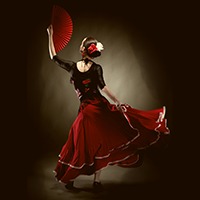Our member Ms S. Chakrabarti is an avid traveller. She reminisces one of her
favourite dance form of Spain ‘Flamenco’ and shares a brief description of its origin.
Spain, formally the Kingdom of Spain is a Democratic Monarchy located in
the southwest side covering approximately 85% of the total area of Europe. It has
been divided into 17 administrative departments all under the autonomous body of
Spain. These are also called historical zones or in their language ‘Comunidad
autonoma’.
Seville, Andalusian Spanish is the capital and largest city of the Spanish
autonomous community of Andalusia and the province of Seville. One of the most
important characteristics of Seville is Flamenco dance. Spain is famous for being the
Flamenco capital of the world.
The participants of this dance form sing and dance themselves . Flamenco singers
can easily convey their emotions to the audience through their drama and
passion. These songs are basically folk music and like many other country's folk
music, it has a passionate expression of their love and grief.
Aptly complemented by the Spanish bass, the performers express their love
and emotions through these songs and dances. A deep pathos can be felt in the
music, though it is not that there is always grief associated with it, but there are a
gamut of emotions ranging from passion, desire, humour, satire etc that make it a
scintillating watch for the audience.
Flamenco musicians known as ‘Cantor’ are mainly male artist, the girls are
called ‘Cantaora’ and the dancers are called the ‘Bailor’. The song and dance are
presented mainly with the jingle of guitar and the guitarists are called ‘Tacor’. Every
stomp of the dancer’s feet, strum of the musician’s guitar, and clap of the singer’s
hands make it a breathtaking performance that regales the audience . Earlier, the
dance was performed with songs and making sound on wooden platforms with
the pacy beats of clapping hands. At times clapping is replaced by an instrument called ‘Castanets’. The tapping of feet reminds one of “Kathak”, the Indian dance
form that also involves hand movements and extensive footwork. The traditional
costume of wearing a long skirt with frills and full sleeve top with sometimes a hat
have changed a bit with time.. Flamenco dance is said to be originated even before
the birth of Muhammad in 570 AD. There are many versions of the origin of the
dance of which one attributes it to a tribe named ‘Baijantais’ whose chanting in the
Church is very similar to the tune of Flamenco songs, while another traces its origin
to Spain. Another version is that the gypsies from Romania travelled through Africa
and brought these songs to Spain. The Romanian gypsies who comprised of
musicians , dancers, traders and metal workers are nomadic groups who used to
travel from one country to another., As a result of that, the dance reflects a mixture
of several culture. . It is even said that the stomping of feet is acquired from the
Indian culture.
“Dibe r nibe milabe milibe jabena phire
Ei bharater mahamanaber sagartire”
“Give and take, mingle and get assimilated and none will depart empty handed from the
great country called India.”
Want to share your experience? Please mail your story to writetous@supportelders.com with your name


